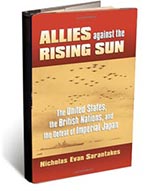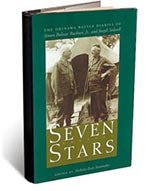BOOKS
The Battle of Manila: Poisoned Victory in the Pacific War
A thrilling and in-depth look at the battle for Manila, the third-bloodiest battle of World War II and the culmination point of the war in the Pacific theater.
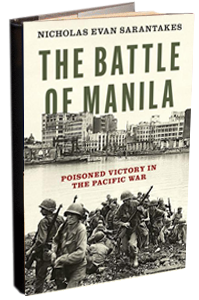
In 1945 the United States and Japan fought the largest and most devastating land battle of their war in the Pacific, a month-long struggle for the city of Manila. The only urban fighting in the Pacific theater, the Battle of Manila was the third-bloodiest battle of World War II, behind Leningrad and Berlin. It was a key piece of the campaign to retake control of the Philippine Islands, which itself signified the culmination of the war, breaking the back of Japanese strategic power and sealing its outcome.
In The Battle of Manila, Nicholas Sarantakes offers the first in-depth account of this crucial campaign from the American, Japanese, and, significantly, Filipino perspective. Fighting was building by building, with both sides forced to adapt to the new combat environment. None of the U.S. units that entered Manila had any previous training in urban warfare--yet, Sarantakes shows, they learned on the fly how to use tanks, flamethrowers, air, and artillery assets in support of infantry assaults. Their effective use of these weapons was an important factor in limiting U.S. casualties, even as it may also have contributed to a catastrophic loss of civilian lives.
The battle was a strategic U.S. victory, but Sarantakes reveals how closely it hinged upon the interplay between a series of key decisions in both U.S. and Japanese headquarters, and a professional culture in the U.S. military that allowed the Americans to adapt faster and in more ways than their opponents. Among other aspects of the conflict, The Battle of Manila explores the importance of the Filipino guerillas on the ground, the use of irregular warfare, the effective use of intelligence, the impact of military education, and the limits of Japanese resistance.
Ultimately, Sarantakes shows Manila to be a major turning in both World War II and American history. Once the United States regained control of the city, Japan was in a checkmate situation. Their defeat was certain, and it was clear that the United States would be the dominate political power in post-war Asia and the Pacific. This fascinating account shines a light on one of the war's most under-represented and highly significant moments.
Fan in Chief
Richard Nixon and American Sports, 1969–1974
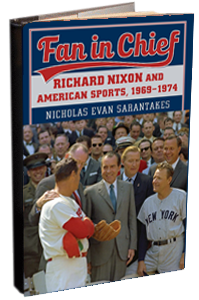
Some presidents throw out baseball’s first pitch of the season. Some post picks for college basketball's March Madness. One might tweet about a football player kneeling. President Richard M. Nixon phoned Miami Dolphins coach Don Shula to suggest plays for the Super Bowl. He hosted players in the 1969 Major League All-Star game for a party deemed the strangest since the mob scene during Andrew Jackson's inauguration. He attended a Washington Redskins practice to boost moral; altered the NFL’s policy for televising home games; introduced the practice of calling teams after Super Bowl or World Series wins. The list goes on, but the point is clear: Richard Nixon was the nation’s first sports super fan to occupy the Oval Office. And this, Nicholas Evan Sarantakes suggests, may explain why Nixon, so despised for all his faults and failings, was nonetheless also widely loved by the American public.
In Fan in Chief Sarantakes sets out to show how Richard Nixon's passion for sports, more than policy positions or partisan politics, engaged the American people-and how Nixon used this passion to his political advantage. Fan in Chief takes place in the realm of political theater, a theater in which the president’s role was perfectly genuine. A true fan, Nixon exposed core elements of his personality, character, and values in the world of sports; through sport he could connect and communicate with the character and values of his fellow Americans. Fan in Chief is thus a story of both personality and politics; but more than that, it is an in-depth exploration of what Richard Nixon’s love of sport can tell us about the man and his times.
Making Patton
A Classic War Film's Epic Journey to the Silver Screen

Forever known for its blazing cinematic image of General George S. Patton (portrayed by George C. Scott) addressing his troops in front of a mammoth American flag, Patton won seven Oscars in 1971, including those for Best Picture and Best Actor. In doing so, it grossed $60 million despite an intense anti-war climate. It was also a film that almost did not get made.
Sarantakes offers an engaging and richly detailed production history of what became a critically acclaimed box office hit. He takes readers behind the scenes, even long before any scenes were ever conceived, to recount the trials and tribulations that attended the epic efforts of producer Frank McCarthy and Twentieth Century Fox to finally bring Patton to the screen after eighteen years of planning.
Sarantakes recounts how filmmakers had to overcome the reluctance of Patton’s family, copyright issues with biographers, competing efforts for a biopic, and Department of Defense red tape. He chronicles the long search for a leading man—including discussions with Burt Lancaster, John Wayne, and even Ronald Reagan—before settling on Scott, a brilliant actor who brought to the part both enthusiasm for the project and identification with Patton’s passionate persona. He also tracks the struggles to shoot the movie with a large multinational cast, huge outlays for military equipment, and filming in six countries. And he provides revealing insider stories concerning, for example, Scott’s legendary drinking bouts and the origins of and debate over his famous opening monologue.
Drawing on extensive research in the papers of Frank McCarthy and director Franklin Schaffner, studio archives, records of the Academy of Motion Picture Arts and Sciences, contemporary journalism, and oral histories, Sarantakes ultimately shows us that Patton spoke to national ideals while exposing complex truths about power in the mid-twentieth century.
Dropping the Torch
Jimmy Carter, the Olympic Boycott, and the Cold War

In this book, Sarantakes offers a diplomatic history of the 1980 Olympic boycott. Broad in its focus, it looks at events in Washington, D.C., as well as the opposition to the boycott among the international Olympic movement both in the United States and abroad. He examines not only the diplomatic efforts to stop this gathering, but also how this attempted embargo ultimately affected the athletic contests in Moscow. Jimmy Carter based his foreign policy on assumptions that had fundamental flaws and reflected a superficial familiarity with the Olympic movement. These basic mistakes led to a campaign that failed to meet its basic mission objectives but did manage to insult the Soviets just enough to destroy détente and restart the Cold War. The book also includes a military history of the Soviet invasion of Afghanistan, which provoked the boycott, and an examination of the boycott’s impact four years later at the Los Angeles Olympics, where the Soviet Union retaliated with its own boycott.
Despite the title, this book has an international focus. Sarantakes based his account on a diverse set of records from the Carter White House to minutes of the International Olympic Committee. All in all, he cites material in six different languages (English, French, German, Russian, and Japanese) from over 20 countries.
Allies against the Rising Sun
The United States, the British Nations, and the Defeat of Imperial Japan
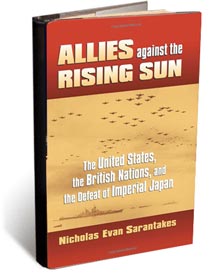
The role of America’s British allies in the Pacific Theater has been largely ignored. Nicholas Sarantakes now revisits this seldom-studied chapter, offering the most detailed assessment ever published of the U.S. alliance with Great Britain, Australia, New Zealand, and Canada.
Sarantakes examines Britain’s motivations for participating in the invasion of Japan, the roles envisioned by its Commonwealth nations, and the United States’ decision to accept their participation. He shows how maintaining the coalition, even in the face of a number of disputes, served the interests of ever coalition member.
Sarantakes describes how Churchill favored British-led operations to revive the colonial empire, while his generals argued that Britain would be further marginalized if it did not fight alongside the United States in the assault on Japan’s home islands. Commonwealth partners saw an opportunity to support the mother country in service of their own separatist ambitions. And even though the United States called the shots, it welcomed allies to share the predicted casualties of an invasion.
Sarantakes takes readers into the halls of both civil and military power in all five nations to show how policies and actions were debated resolved. He not only describes the participation of major heads of state but also brings in a cast of military leaders including General of the Army Douglas MacArthur and Fleet Admiral Chester Nimitz on the American side and Admiral of the Fleet Sir Andrew Cunningham and Field Marshal Sir Alan Brooke on the British. He also paints vivid scenes of battle, including the attack of the British Pacific Fleet on Japan and ground fighting on Okinawa.
Blending diplomatic, political, and military history encompassing naval, air, and land forces, Sarantakes’s work reveals behind-the-scenes political factors in warfare alliances and explains why the Anglo-America coalition survived World War II when it had collapsed after World War I.
Seven Stars
The Okinawa Battle Diaries of Simon Bolivar Buckner, Jr. and Joseph Stilwell
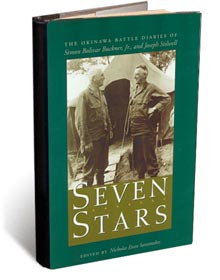
Battle diaries are essential for understanding what generals are thinking as they work their way through the fog of battle. Nicholas Sarantakes juxtaposes the diaries of two very different generals who both fought at Okinawa: Lt. Gen. Buckner, a by–the–numbers man who favored the use of artillery and tanks to reduce entrenched positions, and Gen. Stilwell, a prickly outsider who preferred maneuver to set–piece battles. Sarantakes identifies individuals, includes explanations of important events alluded to by the generals and provides glossaries of main characters and military terms. The result is a record of how Buckner and Stilwell came to grips with the problems of command on a war-torn island at the end of a long logistical tether.
With the background information provided by Sarantakes, the diaries of these men become accessible to the reader. Buckner is the more restrained, a southern gentleman whose career was average and whose diary entries are interspersed with letters to his wife. He shuttles between forward command posts and shipboard conferences, noting how much rain has fallen, how many enemy have been killed, and how many aircraft have been shot down.
Stilwell is a self-styled outsider, a brilliant warrior with the social graces of a porcupine. He dislikes Buckner and has little patience for his irreverent humor. Stilwell’s entries are peppered with frank and often acrid observations about everything and everybody. He dismisses the British as “hoggish, inconsiderate” Limeys and atomic scientists as “temperamental bugs.”
The battle for Okinawa was a pivotal event in World War II and has the distinction of being the single bloodiest conflict in the history of the United States Navy. This book is a fascinating exploration of the art of leading troops in battle and will interest scholars and students of the Pacific War.
Keystone
The American Occupation of Okinawa and U.S.-Japanese Relations

Following the battle of Okinawa in 1945, the United States ruled this island its surrounding atolls as a colony in everything but name until 1972. The island had been the strategic keystone of the American postwar base system of double containment in the Pacific and the only spot in that chain that American officials insisted on governing under the legal cover of “residual sovereignty.”
Why had the United States insisted on administering an entire province of a country that it otherwise called an ally? And why did the Americans return Okinawa when they did? In this thoroughly researched, carefully argued work, Sarantakes argues that policy makers in Washington worried that the Japanese might return to their aggressive and expansionistic prewar foreign policies after the occupation of Japan ended. Even after it was abundantly clear that Japan posed no threat to its neighbors, the United States insisted on retaining the island, fearing that Japan might adopt a policy of neutrality during the Cold War.
Sarantakes uses recently declassified documents to examine America's larger strategic purposes during this period. The story he tells includes soldiers fighting in combat, mobs rioting, diplomats navigating the dangerous waters of power, and clever politicians on both sides of the indigo-colored Pacific taking high-risk gambles. In telling this tale, he brings our attention to an episode in American foreign relations that has been taken for granted for half a century.


